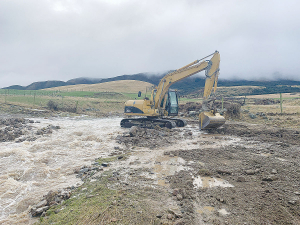M.I.A.
OPINION: The previous government spent too much during the Covid-19 pandemic, despite warnings from officials, according to a briefing released by the Treasury.
 Recent floods are a good reminder of how well we manage infrastructure assets in the regional sector, and the importance of this work to protect communities from the risks of flooding.
Recent floods are a good reminder of how well we manage infrastructure assets in the regional sector, and the importance of this work to protect communities from the risks of flooding.
OPINION: As I write, our nation has returned to lockdowns and it has given me time to reflect on all we have accomplished in the year since the Covid-19 pandemic hit this country hard.
Part of what we have accomplished here at Waikato Regional Council is due to the Government’s economic response to Covid-19 – the provision of funding to cushion the financial blow to whānau and families, workers, businesses and communities from the impacts of the lockdown – through what’s known as shovel ready projects.
This council received a total contribution of around $29 million in shovel-ready project funding for multiple environmental restoration, biosecurity and climate resilience infrastructural multi-year projects totalling about $48 million across the Waikato region to help reset and rebuild the economy.
In the past year, thanks to that funding, we have been able to award 31 contracts to local businesses and see the equivalent of 34 people gainfully employed.
In the environmental restoration space, 25 hectares of land has been retired, 47.5 kilometres of fencing has been done, 110,081 native plants and 26,695 willow and poplar plants for erosion control have gone in the ground, and 133 hectares of land has been controlled for pest plants. Of these projects, the Piako River Green Corridor alone will see 36km of riparian margin planted with a quarter of a million native plants over the next five years.
The benefits of these projects include a reduction of sediments and contaminants to our waterways. This will improve water quality and enhanced habitats for our native species.
Shovel ready funding has enabled us to start six flood protection projects in the Waikato – that will involve upgrading our stopbanks and pump houses, rationalising assets and replacing ageing pumps with new fish-friendly versions. The first of five fish-friendly pumps is due to be installed at Aka Aka, near Waiuku, and is quite an impressive looking piece of kit at 10 metres in length and 1.6 metres in diameter.
The July floods on the West Coast and in the Marlborough district are a good reminder of how well we manage our infrastructure assets in the regional sector, and the importance of this work to protect our communities from the risks of flooding.
The regional sector tour ahead of the Local Government New Zealand conference in the Marlborough district visited the Wairau River just five days before it flooded. It was hard to imagine at the time the enormous floodplain ever fully flowing. The stopbanks had been built after the 1983 floods and never been tested. That test came with the deluge that followed in July, with the stopbanks full to the brim and overtopping, but doing the job they were designed to do.
Three quarters of the Waikato benefits from flood protection, but the work that’s done is not always understood by our communities. Flood protection safeguards lives and property, enables productive use of land, and protects services such as water supply, power, telecommunications and roading networks. Our schemes are built to protect against a certain level of flooding, and no more.
When flood protection works well, it becomes invisible or taken for granted. But there’s always risk. Just as we have seen recently in other parts of New Zealand.
Russ Rimmington is chair of Waikato Regional Council. Views are his own.
Another Australian state has given the green light to virtual fencing, opening another market for Kiwi company Halter.
Farmer interest continues to grow as a Massey University research project to determine the benefits or otherwise of the self-shedding Wiltshire sheep is underway. The project is five years in and has two more years to go. It was done mainly in the light of low wool prices and the cost of shearing. Peter Burke recently went along to the annual field day held Massey's Riverside farm in the Wairarapa.
Applications are now open for the 2026 NZI Rural Women Business Awards, set to be held at Parliament on 23 July.
Ravensdown has announced a collaboration with Kiwi icon, Footrot Flats in an effort to bring humour, heart, and connection to the forefront of the farming sector.
Forest & Bird's Kiwi Conservation Club is inviting New Zealanders of all ages to embrace the outdoors with its Summer Adventure Challenges.
Fonterra has slashed another 50c off its milk price forecast as global milk flows shows no sign of easing.
President Donald Trump’s decision to impose tariffs on imports into the US is doing good things for global trade, according…
Seen a giant cheese roll rolling along Southland’s roads?